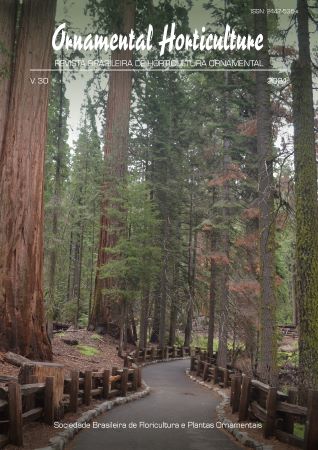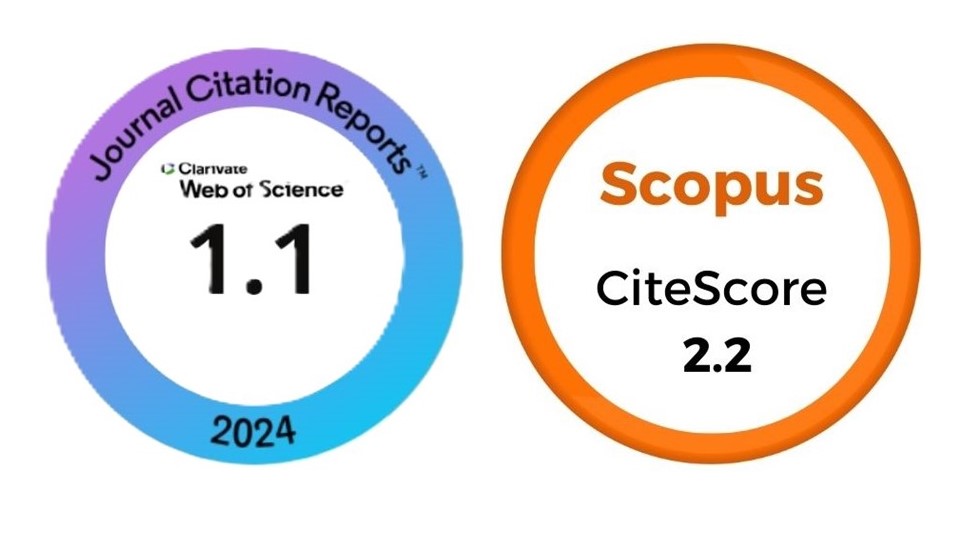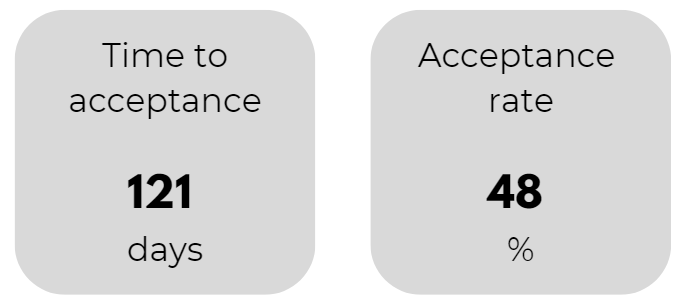The brazilian native orchid Brassavola tuberculata Hook.: ornamental potential and reintroduction
DOI:
https://doi.org/10.1590/2447-536X.v30.e242768Keywords:
landscaping, natural environment, Orchidaceae, substratesAbstract
The use of native species in landscaping has gained prominence due to their adaptability and sustainability compared to exotic species. To introduce a new plant into landscaping, it is necessary to define desirable ornamental characteristics. This study aimed to evaluate the ornamental potential and the feasibility of reintroducing the brazilian native orchid Brassavola tuberculata Hook. in natural environments, aiming for its use in sustainable landscaping with and without fertilization. The research was conducted in two main stages. In the first stage, the morphological characteristics of three individuals with floral buds were analyzed, focusing on quantitative aspects. The results showed that the species presents elegant inflorescences and fragrant flowers, with slightly yellowish white petals and a labellum articulated at the base. In the second stage, 20 plants originating from asymbiotic seeding, approximately 10 cm in height, were reintroduced into phorophytes of Hymenaea courbaril. A mixture of buriti palm fiber and coconut chips was used as the substrate. The plants were divided into two groups: one received 12 g of controlled-release fertilizer (NPK 15-15-15 + micronutrients) and the other received no fertilization. Evaluations were carried out on the day of reintroduction (day zero) and at 7, 14, 21, 30, 60, 90, 120, 180, and 360 days after reintroduction. The results indicate that the morphological aspects of B. tuberculata attribute ornamental potential to the species, and it can be successfully reintroduced into natural environments, even without fertilization. The plant demonstrated a remarkable ability to adapt and survive, reorganizing its metabolism to cope with initial stress.
Downloads
References
BARBERENA, F.F.V.A.; SOUSA, T.S.; ROCHA JUNIOR, J.A.L. Mapeamento de ameaças às populações de orquídeas em uma área de proteção ambiental na Bahia, nordeste do Brasil. Oecologia Australis, v.23, n.2, p.346-356, 2019. https://doi.org/10.4257/oeco.2019.2302.12
BASTOS, F.E.A.; GRIMALDI, F.; KRETZSCHMAR, A.A.; RUFATO, L. Propagation of native plants with ornamental potential from Serra do Oratório, Santa Catarina State, Brazil. Ornamental Horticulture, v.26, n.2, p.298-305. 2020. https://doi.org/10.1590/2447-536X.v26i2.2155
CASTRO, A.C.R.; CORREIA, D.; SOUZA, F.V.D.; SOUZA, E.H.; FRANCO, J.; CAVALCANTI, T.B.; SILVA, D.A. Brazilian ornamental phytogenetic resources in Embrapa germplasm banks: obstacles and opportunities. Ornamental Horticulture, v.28, n.4, p.396-406, 2022. https://doi.org/10.1590/2447-536X.v28i4.2549
CUNHA, M.F.B.; FORZZA, R.C. Orchidaceae no Parque Natural Municipal da Prainha, RJ, Brasil. Acta Botânica Brasílica, v.21, n.2, p.383-400, 2007. https://doi.org/10.1590/S0102-33062007000200013
DORNELES, L.T.; TREVELIN, V. Aclimatação e reintrodução de Cattleya intermedia Graham. ex Gancho. (Orchidaceae) obtidas por propagação in vitro. Iheringia, v.66, p.167-174, 2011.
EMER, A.A. Controlled release fertilizer used for the growth of Campo-manesia aurea seedlings. Ornamental Horticulture, v.26, n.1, p.35-44, 2020. https://doi.org/10.1590/2447-536X.v26i1.2020
ENDRES JÚNIOR, D.; SASAMORI, M.H.; PETRY, C.T.; DROSTE, A. Responses of translocated Cattleya intermedia (Orchidaceae) to environmental key features in a vertical gradient of subtropical forest, Brazil. Revista Brasileira de Geografia, v.17, n.1, p.668-688, 2024. https://doi.org/10.26848/rbgf.v17.1.p668-688
ENDRES JÚNIOR, D.; SASAMORI, M.H.; SILVEIRA, T.; SCHMITT, J.L.; DROSTE, A. Reintrodução de Cattleya intermedia Graham (Orchidaceae) em borda e interior de um fragmento de Floresta Estacional Semidecidual no sul do Brasil. Revista Brasileira de Biociências, v.13, n.1, p.33-40, 2015.
FIETZ, C.R.; FISCH, G.F.; COMUNELLO, E.; FLUMIGNAN, D.L. O clima da região de Dourados, MS. 2. ed. Dourados: Embrapa Agropecuária Oeste, 2017.
FLORA E FUNGA DO BRAZIL. Jardim Botânico do Rio de Janeiro. Available at: <http://floradobrasil.jbrj.gov.br> Acessed in: 23 May 2024.
LEAL, L.; BIONDI, D. Potencial ornamental de espécies nativas. Revista Científica Eletrônica de Engenharia Florestal, v.4, p.1-16, 2006.
MOREIRA, M.M.; BARBERENA, F.F.V.A.; LOPES, R.C. Orchidaceae da restinga de Grumari: florística e similaridade entre restingas do estado do Rio de Janeiro, Brasil. Acta Botânica Brasileira, v.28, n.3, p.321-326, 2014. https://doi: 10.1590/0102-33062014abb3173
NOGUERA-SAVELLI, E. Sistemática del género neotropical Brassavola (Orchidaceae). Caldasia, v.42, n.2, p.188-219, 2020. https://doi.org/10.15446/caldasia.v42n2.68125
OSTETTO, S. Orquídeas de Mato Grosso do Sul. Campo Grande: Alvorada. p.14, 2015.
SALSINHA, Y.C.F.; SEBASTIAN, A.; SUTIYANTI, E.; PURWESTRI, Y.A.; INDRADEWA, D.; RACHMAWATI, D. The relationship between morpho physiological changes and expression of transcription factors in NTT local rice cultivars as a response to drought stress. Indonesian Journal of Biotechnology, v.27, n.1, p.8-18, 2022. https://doi.org/10.22146/ijbiotech.65728
SILVA, F.M.T.; BARBOSA, W.M.; FERREIRA JÚNIOR, W.G. Morphoanatomical characterization of Brassavola tuberculata Hook’s (Orchidaceae) leaf and root upon the rocky outcrop. Agrogeoambiental, v.13, n.4, 2021. http://dx.doi.org/10.18406/2316-1817v13n420211646
SOARES, J.S.; RAMOS, J.C.M.; SORGATO, J.C.; RIBEIRO, L.M.; REIS, L.C. Brassavola tuberculata Hook.: in vitro growth and ex vitro establishment as a function of the micropropagation system and sucrose. Brazilian Journal of Biology, v.83, e.270892, 2023. https://doi.org/10.1590/1519-6984.270892
SOARES, J.S.; SANTIAGO, E.F.; SORGATO, J.C. Conservação de Schomburgkia crispa Lindl. (Orchidaceae) por reintrodução em um fragmento de Cerrado brasileiro. Journal for Nature Conservation, v.53, p.1617-1381, 2020. https://doi.org/10.1016/j.jnc.2019.125754
SORGATO, J.C.; SOARES, J.S.; RIBEIRO, L.M.; CABRAL, A.G. Ornamental potential of Schomburkgia crispa Lindl. Ornamental Horticulture, v.27, n.2, p.155-161, 2021. https://doi.org/10.1590/2447-536X.v27i2.2277
SOUSA, G.G.; ROSA, Y.B.C.J.; MACEDO, M.C.; SOARES, J.S. Aclimatização de Brassavola tuberculata com a utilização de ANA em diferentes substratos. Horticultura Brasileira, v.33, n.2, p.208, 2015. https://doi.org/10.1590/S0102-053620150000200012
WFO (2024): World Flora Online. A working list of all plant species. 2024. Available at: . Acessed in: 23 May 2024.
ZARATE-GARCÍA, A.M..; NOGUERA-SAVELLI, E.; ANDRADE-CANTO, S.; ZAVALETA-MANCERA, H.A.; GAUTHIER, A.; AL-TORRE-COBOS, F. Bark water storage capacity influences epiphytic orchid preference for host trees. American Journal of Botany, v.107, n.5, p.726-734, 2020. https://doi.org/10.1002/ajb2.1470
ZHANG, S. Diversidade fisiológica de orquídeas. Diversidade Vegetal, v.40, p.196-208, 2018.
ZUCCHI, M.R. Ornamental and landscape potential of a bromeliad native to the Cerrado. Ornamental Horticulturev.25, n.4, p.425-433, 2019. https://doi.org/10.1590/2447-536x.v25i4.2003
Downloads
Published
Issue
Section
License
Copyright (c) 2024 Ornamental Horticulture

This work is licensed under a Creative Commons Attribution 4.0 International License.








